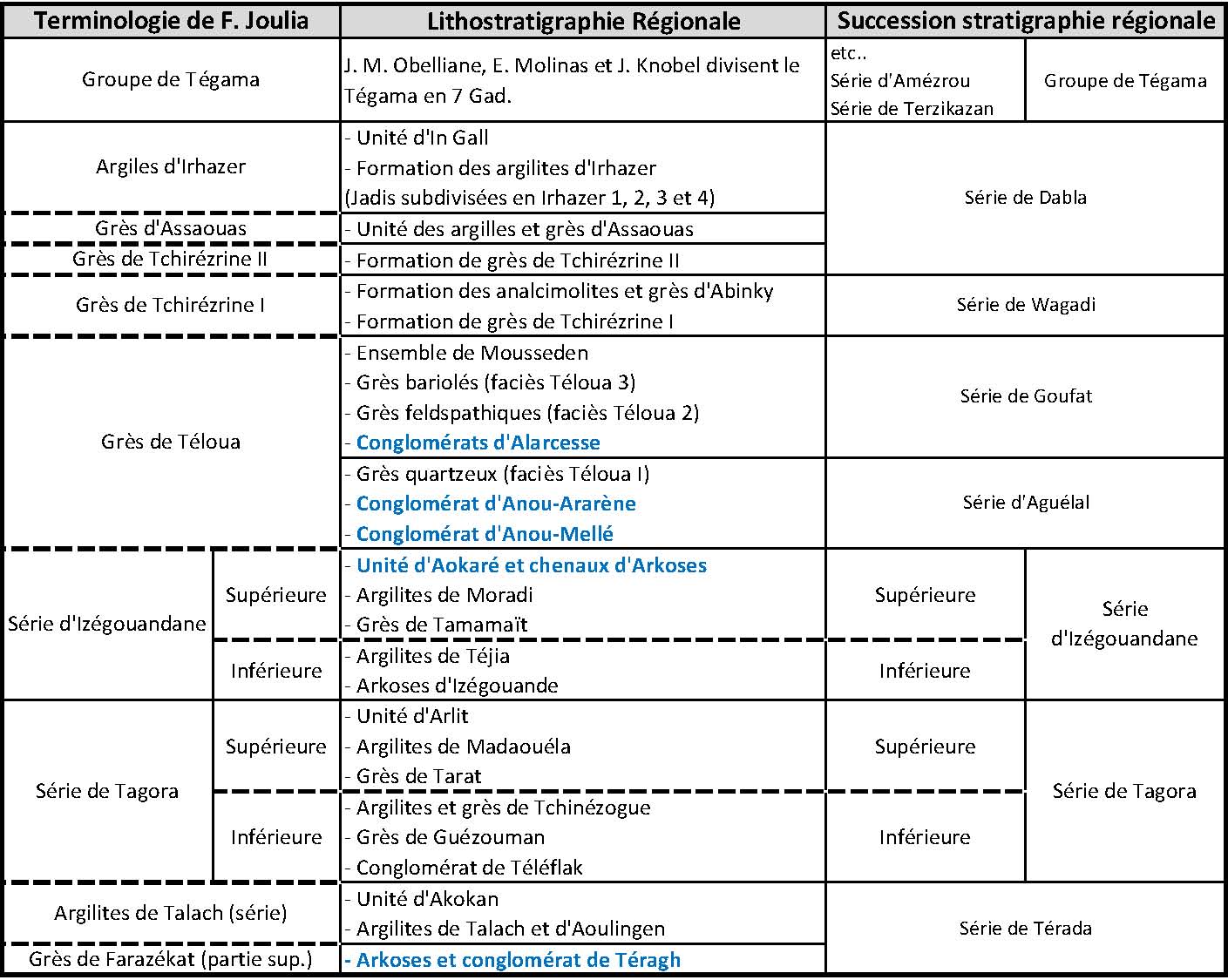Agadez Gr
Type Locality and Naming
From Mount Ibadaman on the 7° meridian to the South-West horn of Aïr. Chudeau, 1908.
Subgroups: Upward succession of Goufat, Wagadi, Lower Dabla. Dabla Subgroup - The lower portion is in the Agadez Gr, while the top is in the Irhazer Gr (the Tiouraren Fm). Dabla Subgroup includes the Tchirezrine 2 Mbr of the Tchirezrine Fm at Assaouas (at the base), the Assaouas Fm at the center, and the Irhazer Fm and Tiouraren Fm at the top => the lower portion is in the Agadez Gr (with Wagadi Subgroup below), while the top is in the Irhazer Gr (the Tiouraren Fm); and is 400 m when complete. Wagadi Subgroup outcrops to the west and the southwest of the Aïr in discordance with the Goufat Subgroup. It offers two facies which stand out as two Members of the Tchirezrine Fm: the sandstones of the Tchirezrine 1 Mbr at the base and the sandstones and analcimolites of the Abinky Mbr at the top (Abinky Mbr); two of the three Members of the Tchirezrine Fm (see the definition of both units for details). The Wagadi Subgroup is a fining upward sequence. Goufat Subgroup is a fining upward succession of the Teloua 2 and Teloua 3 Members of the Teloua Fm, then the Mousseden Fm. [See individual formations for details.].
References: Chudeau, 1908; Greigert et al., 1954; Faure et al., 1956; Greigert & Pougnet, 1967, p. 108; Bigotte & Obelianne, 1968; Valsardieu, 1971; Fabre et al., 1983; Moody & Sutcliffe, 1991; Kogbe, 1991; Wagani et al., 2011; Billon et al., 2016.
Synonym: Grès d’Agadès; Grès d’Agadez; For Dabla Subgroup - Série de Dabla; For Wagadi Subgroup - Série de Wagadi
Lithology and Thickness
The Agadez Gr (together with the Izégouandane Gr of the Permian Period) corresponds to red detrital deposits of the Tim Mersoï Sub-Basin. It is derived from alteration products generated by a hot climate with seasonal variations (wet and dry). Volcanic inflows have been recorded in this group in the form of rhyolitic pebbles and ash. ~270 m thickness. The subdivisions of this group adopted in this lexicon are from top to bottom:
- Assaouas Fm (sandstone) at the top (a few meters to 30 m). Dinosaurians and a level mineralized in copper and uranium are found in it.
- Tchirezrine Formation
- Tchirezrine 2 Mbr (70 m)
- Abinky Mbr (~25 m)
- Tchirezrine 1 Mbr (50 m)
- Mousseden Fm (analcimolites) (0-30 m)
- Teloua Fm (sandstones and locally intercalated with conglomerates and some clay beds) (Teloua 1, 2, 3 Mbrs) (80 m)
Note that the Alarcess conglomerate (Fig. 1) (0 to 10 m) containing pebbles of eruptive rocks is now incorporated within the Teloua 2 Member of the Teloua Fm (see the definition of this term).
Earlier, Bigotte and Obelianne (1968) had subdivided this continental group, comprised between two discordances, into six cycles which were from top to bottom: analcimolites of Abinky, sandstone of Tchirezrine 1 resting in discordance on the analcimolites of Mousseden Fm; finally, sandstones of Teloua 3, 2, 1. This stratigraphy was supplemented and specified later (Valsardieu (1971)). [See individual formations for details.]
[Figure: Facies of Agadez Gr]
Relationships and Distribution
Lower contact
Resting in discordance on the Izégouandane Group or the crystalline basement.
Upper contact
Overlying unit is the Irhazer Gr / Irhazer Fm. For the Dabla Subgroup, the overlying unit is the Tégama Group.
Regional extent
Iullemmeden Basin - Tim Mersoï Sub-basin. Goufat Subgroup accumulated at the site of Western Aïr in a large south-north sedimentary deposition area, bordered by reliefs to the west and especially to the east where volcanoes were present during the Permian.
GeoJSON
Fossils
Dinosaurians (TAQUET 1976); Fossilized/silicified wood (Dadoxylon) (Greigert et al. (1958). For Dabla Subgroup - Silicified wood (Tchirezrine 2 Mbr). Invertebrates, vertebrate tracks, large plant imprints in the sandstones, fish, dinosaurs, and plants (Irhazer Fm). Estheries (Euestheria lamberti, E. margínata, DEFRETIN et al., 1956), lamellibranchs (Cuneopsis, Unio, Cyrena, MONGIN, 1963), vertebrate remains (Sauropods, Theropods, Crocodiles, fish) and pentadactyles and tridactyles tracks (de Lapparent et al., 1966) have been found in the unit of Assaouas Fm and the Irhazer Fm. The flora is represented mainly by imprints of Laccopteris, Equisetites. For Wagadi Subgroup - Silicified woods (Dadoxylon)
Age
Depositional setting
Fluvial and lacustrine. Wagadi Subgroup of sandstones, usually red to grey, occur in stacked, planar cross-bedded sets representing a series of migrating dune beds formed in a shallow braided river system. The whole Wagadi Subgroup is the product of fluvial sedimentation on a large flood plain by a river heading north in an unstable period (tectonics of faults and flexures, volcanism).
Additional Information
In the Agadez Group, the Anou Ararène and Anou Mellé conglomerates are part of the Teloua formation of Joulia (1959). In the present publication, the Anou Ararène and the Anou Mellé conglomerates are now included within the Teloua 1 facies, while the Alarcess conglomerate is included within the Teloua 2 facies (Fig. 1)
